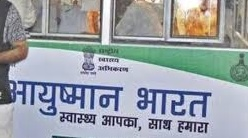New Delhi, 1 April (IANS). According to the latest data of the Ministry of Health, the number of beneficiaries of the Central Government Health Scheme (CGHS) has increased from 34.2 lakhs to 39 percent in 2019-20 to 47.6 lakhs in 2023-24.
Meanwhile, private hospitals listed under CGHS have increased from 24 percent in 2019-20 to about 60 percent in 2023-24.
In December last year, CGHS issued an advice to listed hospitals, stating that the directorate has come to mind that some healthcare organizations ‘are involved in fraud activities while depositing the bill.’ Along with this, reports have been reported to pay more fees, to treat and other complaints.
The total expenditure on CGHS between 2019-20 and 2023-24 increased by 54 percent.
The Central Government Health Scheme (CGHS) provides large -scale health services to central government employees, pensioners and their dependents.
It provides medical facilities through a large network of wellness centers and listed hospitals, including consultation, treatment, diagnosis and medicines, which ensure accessible and inexpensive healthcare.
Meanwhile, according to the latest data of ‘Ayushman Bharat Digital Mission’, now more than 76 crore Indians have Ayushman Bharat Health Account (ABHA) ID.
ABHA, a major component of Ayushman Bharat Pradhan Mantri Jan Arogya Yojana (AB-PMJAY), is an account/number, which is used to add all the health records of a person. ABHA aims to reduce the expenses incurred from pockets for the beneficiaries and improve access to quality healthcare.
According to the latest data, 55,10,259 ‘Ayushman Bharat Health Account’ accounts were opened in March so far, out of which 1,67,257 have been opened on Wednesday. Uttar Pradesh has the highest number of 1,319.1 lakh health accounts, followed by Rajasthan with 623.8 lakh health accounts and Maharashtra with 585.9 lakh health accounts.
AB-PMJAY is the world’s largest health insurance scheme, which has recently added another achievement to all the senior citizens above 70 years of age by giving free health coverage.
This step has been taken at a time when it is estimated that by 2050 India’s elderly population will double and this will increase the demand for old age care. By 2050, one in every five person in India is expected to be elderly.
-IANS
SKT/ABM









